#1720s dress
Text


Brown Embroidered Silk Dress, ca. 1725, British.
Met Museum.
#brown#embroidery#womenswear#extant garments#dress#silk#1725#1720s#1720s britain#British#1720s dress#1720s extant garment#met museum
368 notes
·
View notes
Photo
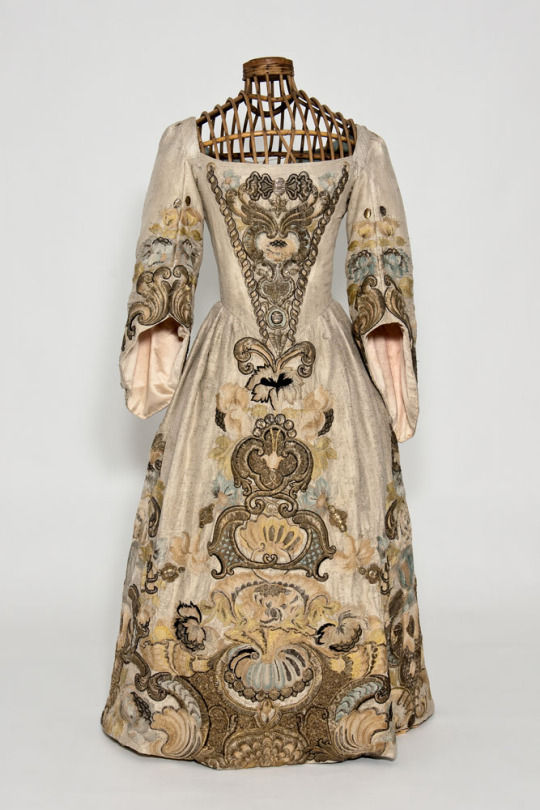
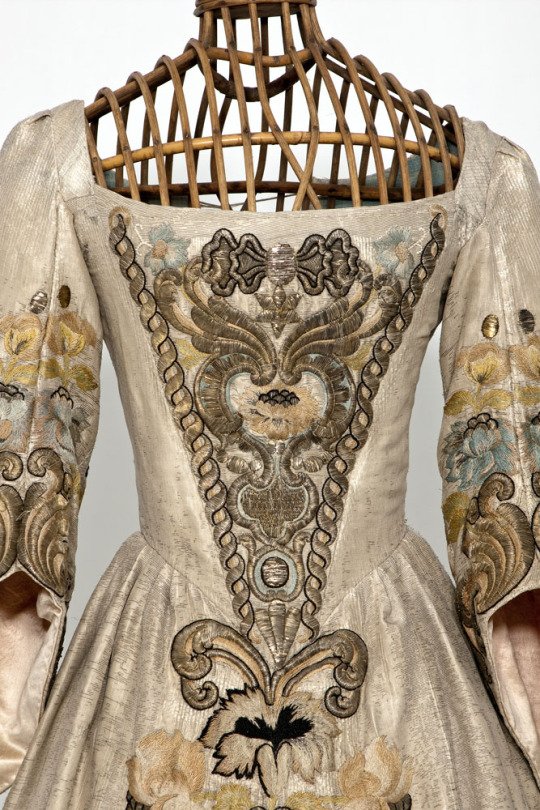
ab. 1720 Woman’s or probably girl’s dress (France)
silk, silver embroidery, linen
(North Bohemian Museum)
2K notes
·
View notes
Text

Elsie Rutgers Schuyler Vas Petrus by Gerardus I. Duyekinck, 1723, Albany.
18 notes
·
View notes
Photo
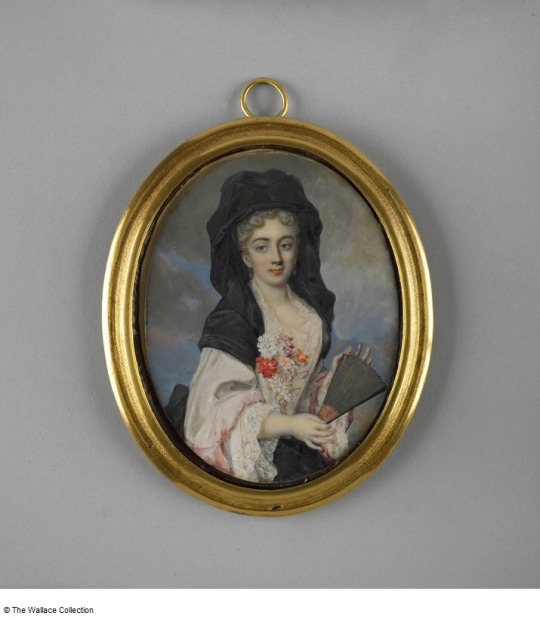
An Unknown Lady in an Italian Dress, Rosalba Carriera, 1710-20
#an unknown lady in an Italian dress#Rosalba carriera#carriera#1710#1710s#1720#1720s#1700s#18th century#painting#portrait#miniature#art
61 notes
·
View notes
Text
Two notorious cross-dressing women became female pirates: Mary Reid and Anne Bonny, whose story was published as A General History of the Pirates in 1724.

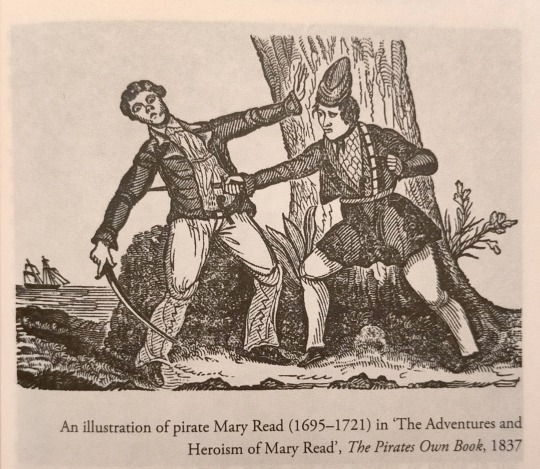
"Normal Women: 900 Years of Making History" - Philippa Gregory
#book quotes#normal women#philippa gregory#nonfiction#mary read#mary reid#the pirates own book#anne bonny#a general history of the robberies and murders of the most notorious pyrates#a general history of the pirates#20s#1720s#18th century#cross dressing#notorious#pirates
2 notes
·
View notes
Text
Closing the 1720s for now -

1720s Barbara Ivory (d.1748), Mrs Henry Davenport III by Charles d' Agar (Lacock Abbey, Fox Talbot Museum and Village - Lacock, near Chippenham, Wiltshire, UK). From artuk.org 1517X1889.

1721 (after) Tsarevna Anna Petrovna by Ivan I Grigoryevich Adolsky (Hermitage). From arthermitage.org-Ivan-I-Grigoryevich-Adolsky-Portrait-of-Tsarevna-Anna-Petrovna.html 1173X1475.

ca. 1728 Anna Karolina Orzelska by Antoine Pesne (Muzeum Narodowe w Warszawie - Warszawa, Poland)). From Wikimedia 1500X2267.
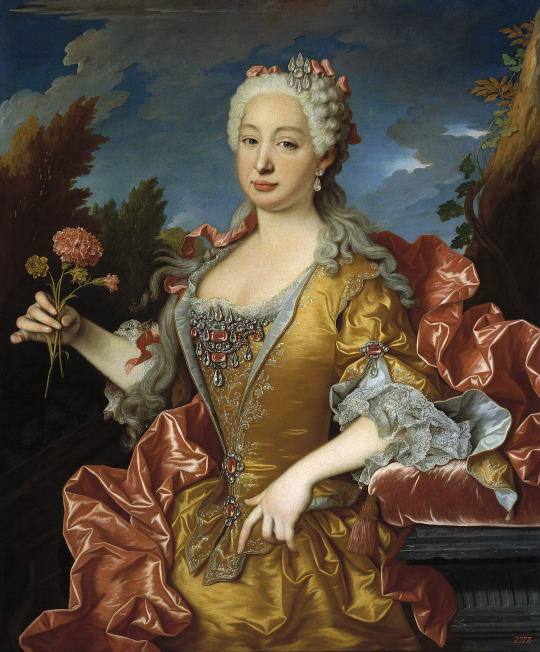
ca. 1729 Queen Maria Barbara of Spain, née Portugal by Jean Ranc (Museo del Prado - Madrid, Spain). From their Web site; fixed spots w Pshop 2445X2953.
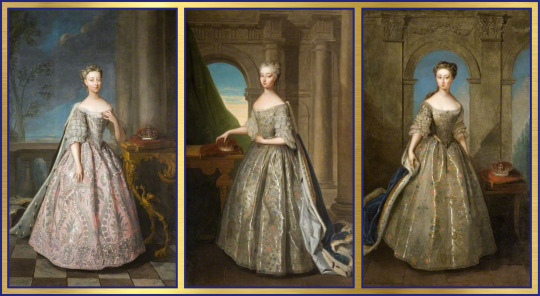
1728 Princess Amelia Sophia, Princess Royal Anne, and Princess Caroline Elizabeth by Philip Mercier (all three at the Hertford Magistrates' Court - Hertford, Hertfordshire, UK). From tumblr.com-search-18th+century 1996X1093.
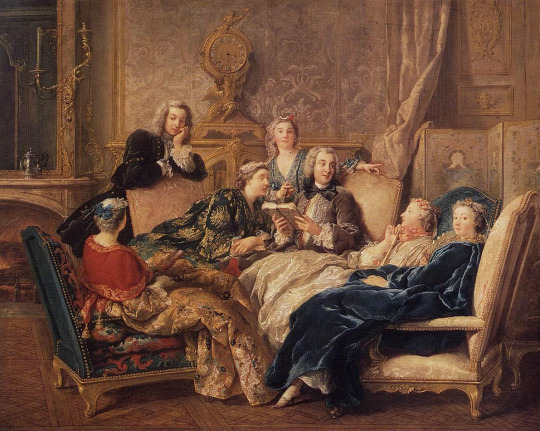
1729 A reading of Mollière by Jean-François de Troy (location ?). From Wikimedia 1191X950.
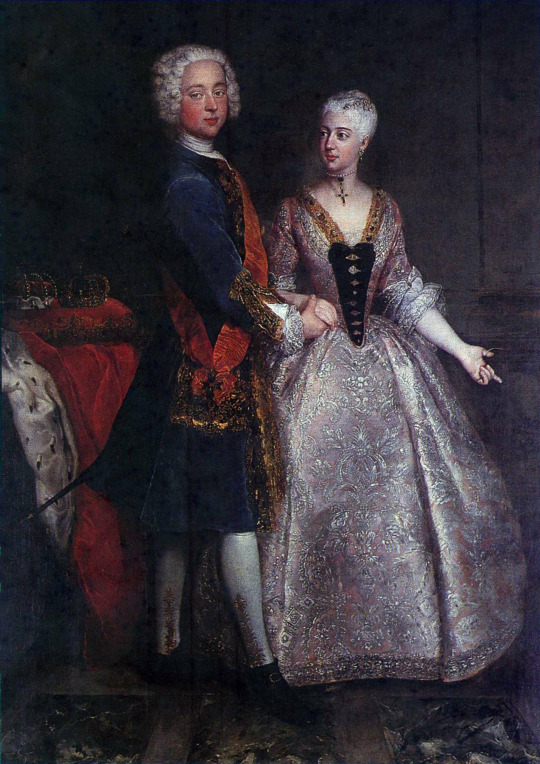
1729 Wedding portrait of Friederike Luise and Karl Wilhelm Friedrich by Antoine Pesne (Schloss Charlottenburg - Berlin, Germany). From Wikimedia 1400X1980.
#1720s fashion#Rococo fashion#Georgian fashion#Louis XV fashion#Barbara Ivory#Charles d' Agar#Anna Petrovna#Ivan I Grigoryevich Adolsky#court dress#Anna Karolina Orzelska#Antoine Pesne#Queen Maria Barbara of Spain#Jean Ranc#Princess Amelia Sophia#Princess Royal Anne (1709 – 1759)#Princess Caroline Elizabeth#Philip Mercier#Jean-François de Troy#robe volant#Princess Friederike Luise#wedding dress
10 notes
·
View notes
Text
Eat Your Young seems to be to be directly inspired by A Modest Proposal by Jonathan Swift, a satire written in the 1720s about the poverty in Ireland and the unhelpful solutions offered by the church and aristocracy at the time, which argues that the poor Irish should sell their children to the rich to be eaten, which would prevent them from burdening their families and the country and instead make them useful. it’s satire, of course, but played straight the entire time.
and here is Hozier, 300 years later, making the exact same point. only the set dressing has changed. with all the abuses people are suffering in war and under capitalism, and with the cost of living and rate of poverty rising with no end in sight, is it not more humane and just as exploitative to simply eat the children the government will not feed? would they not recommend it themselves if only they thought they could get away with it?
the state of the world and the powers that be will continue to try and use us all up and throw us aside anyway.
it’s quicker and easier to eat your young.
8K notes
·
View notes
Note
Hello! I'm trying to draw something for a friend. Both of our characters live in the late 1720s. They both have regular outfits, but I want to draw them wearing something fancy. My friend has described his character as having a very bad sense of fashion. I can't really picture what a bad outfit back then would look like. Do you?
Hello!
Well I haven't got all that much of a feel for what might have been considered a bad outfit back then, but there is one image that immediately comes to mind of someone who's very definitely badly dressed, and it's this guy. From the 4th panel of Hogarth's Marriage A la Mode (1743-45).

His individual garments look fine to me, but they're horribly mismatched! (And a bit old fashioned for the mid 40's.)
You'll note that the coat cuffs are made of a large brocade that contrasts with the main body of the coat, which was very popular in the first half of the century, but that style was meant to be worn with a matching waistcoat in the same brocade. Instead he's got a completely plain waistcoat that doesn't match at all.
And the breeches should match the main coat fabric, but his don't! The black and brown and beige clash awfully.
He's also got a lot more rings and a much bigger & sparklier earring than I've seen on any other guy from the era, which I speculate might have been tack and/or un-masculine, but I have no sources so don't quote me on that.
I just know that when 18th century guys are wearing rings in a portrait it's usually just one, and I've only ever seen simple little hoop earrings in a very few portraits. But again, emphasis on the "speculate" part of that sentence.
(And I've just noticed that the guy next to him has curling papers in his hair, which I think is probably also meant to make him look silly and not properly dressed. No idea what the opinion would have been about the folding fan dangling from the wrist of the next guy over, but it is intriguing. The very large beauty spot on his lip is probably meant to look bad though.)
That painting is a bit later than what you're asking about, but the style of matching cuffs & waistcoat was popular in the 20's too, so here are some examples of what it's supposed to look like.
A lot of them are very elaborate brocades paired with a solid dark coloured velvet, but sometimes it's a contrasting plain fabric with a ton of metal embroidery.
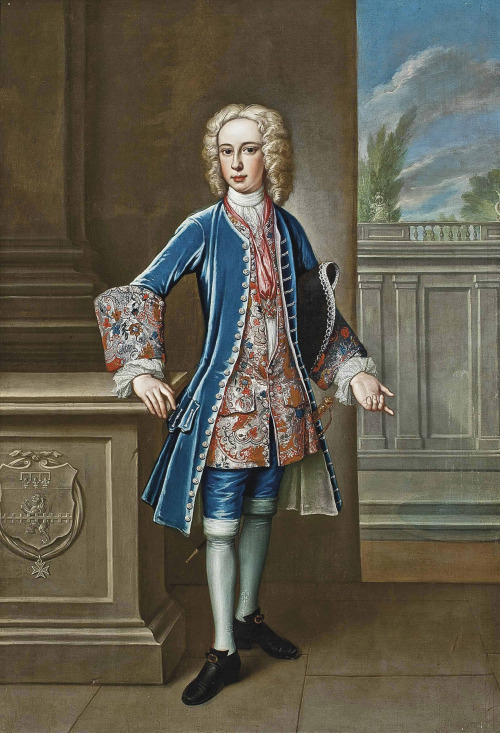
(1725)

(1723)

And an extant c. 1730's example from the NMS collection.
You might also look at 1710's images, because being a decade behind the current fashions would certainly make you badly dressed for the era.

(c. 1715-20)
So, I guess just put them in clashing parts of 2 or 3 different matched suits? (I am assuming you're asking about suits, since this ask was sent to me and I do not know very many things about dresses. Mostly only what I absorb from other costumers who post about it, and barely anyone does early 18th century.)
Please note that this does not apply to the 1780's-90's, fashion plates from those decades are incredibly full of clashing and mismatched suits. (Though it would probably still be bad to wear those ones on a very formal occasion.)
116 notes
·
View notes
Note
Consider, its assumed that Alastor has no family in Hell or that he isn't on good terms with any family members that ARE in Hell. Its not unusual. Most people will either stick with family or avoid them like the plague if they have any family at all, like Angel Dust. His sister is in Heaven but his brother and father (and maybe his mother?) Arackniss and Henroin are both in Hell and they are very clearly NOT on speaking terms. Or even acknowledging terms.
But then the whole Adam thing happens and there's a knock at the door to the newly rebuilt Hotel. Charlie answers and comes face to face with an older deer-like Sinner dressed in fine 1920s vintage with an eerily familiar smile. And behind her is another deer sinner, clearly an older woman with silver hair and familiar red eyes beside an elderly gentleman with a familiar jawline. And... And Charlie realises there's a veritable HERD of deer-like Sinners milling about the courtyard in front of the Hotel doors in clothes from the 1920s to as far back as the 1720s. Eternally old and eternally young alike. She even spots a few kids chasing after one another, their parents shouting after them to wear their shoes so they don't get stones in their hooves or fall and mess up their nice clothes.
Alastor's Maman has Summoned The Family and Heaven help any Sinner who gets between them and the injured member of the herd.
👀
106 notes
·
View notes
Note
Ohhhhh so I have an idea for ....
Forget-me-not and narcissus
You throw yourself in the way to save (clone of your choice), and he gets super angry at you for doing that because he's loved you forever. You both have but never admitted it ...
You can go from there. Love oo
I Don't Want To Forget
Summary: You are a civilian employee on the Resolute and you're a little bit accident prone, which is why you're shocked when General Skywalker wants you out on the battlefield one day. Luckily you have Kix looking out for you...unluckily, you get shot trying to save Kix's life.
Pairing: Clone Medic Kix x F!Reader
Word Count: 1720
Warnings: Reader is shot, and Kix yells
Prompts: Forget-me-not - Don't forget me, Narcissus - unrequited love
Tagging: @trixie2023 @n0vqni @imabeautifulbutterfly
A/N: I'm not so sure about this one. Apparently Kix is a weak spot, lol

“The only reason I’m agreeing to this-”
“-is because it’s not up to you and General Skywalker says that I have to be here?” You interrupt, a small smile on your lips as you look at Kix.
“This isn’t funny.” He hisses, “You have no business being on the battlefield at all.”
“I know, Kix. I’ll be careful, stay by you, and listen to orders. I promise.”
He sighs and rubs his hand over his head, “That doesn’t make this any better, cyare.” He rubs his head a couple more times, and then he steps closer to you, “This armor stays on until you’re back on this ship.”
“Got it.”
“I mean it, unless it needs to come off to save your life, it stays on.”
“Kix, I understand. Really.”
He sighs and starts helping you with the armor. It was specially made for you, which means it fits well, but since you aren’t a soldier, this is the first time you’re wearing it. Hence needing Kix’s help to actually put it on.
After a few minutes, he takes a step back, “There, done.”
You look down at yourself, and at the plain white armor, and then you look back at Kix, “I feel like a kid playing dress up.”
“Well, with luck, this will be the only time you have to wear it.” Kix replies, before he frowns and tugs on the collar of your armor, “It’s a bit too big on you. Have you lost weight?”
“...I’m not answering that.”
“That’s a yes then.” Kix tugs on your armor again, his frown increasing, “There’s not that much give, so you should be fine.” He grabs the helmet off the table next to him and hands it to you, “Put it on.”
“Woo. Helmets. Enclosed spaces. Right around my head.”
“It’s fine, you’ll hardly notice.”
“I’ve had nightmares like this before you know,” You say as you lift your helmet, squeeze your eyes shut, and then pull it on.
There’s quiet for a moment, and then a low chuckle, “You still have your eyes closed don’t you?”
“...maybe.”
“Go ahead and open them.”
You sigh and open your eyes, blinking up at Kix who’s standing a lot closer to you, and seems to be messing with something on your helmet.
“Alright. The helmet fits fine, how are you doing?”
“Uh…this might very well be the worst day of my life.”
“You’re being dramatic.” Kix replies warmly, he messes with something at your neck, “Do you think you’ll be able to work like this?”
“...yeah. Probably.”
“Alright.” Kix pulls his own helmet on, “Do you remember what you’re here to do?”
“Yeah. Get in, check the droid, download what information I can, and get back to the ship.”
“Exactly that.” He lightly raps his knuckles against your helmeted forehead, “There will be no heroics from you, do you understand?”
“Yeah.”
“Alright. Then let's head out. Stay behind me.”
Half an hour later, Kix is carefully leading you through a downed starship, shot down by separatists, and you’re miles away from the rest of the battalion.
Which is a good thing, in this case. The rest of the 501st is fighting the droid army, while you and Kix remain unseen.
And you really meant to follow Kix’s orders.
Partly because a part of you thinks that if you follow Kix’s orders he might think of you more fondly and see you as more than just “that accident prone tech from maintenance”, but mostly because you’re very much not a soldier and having set orders to follow is making this a lot easier.
His order of “no heroics” is very easy to follow.
And you meant to follow it.
Right up until you saw a flash of gold out of the corner of your view screen. You turn slightly and see a beat old golden droid (it almost looked like an old HK unit, but that couldn’t be possible) taking aim at Kix.
And you just reacted.
You lurch forward and place your hands on his pack and push as hard as you can.
Kix stumbles forward, and a curse falls from his lips as he rounds on you, but then there’s a sharp pain in your head, and your helmet vision goes staticy, and there’s nothing.

Kix’s gaze is sharp as he keeps his eyes on his cyare.
It was dumb of her to push him out of the way. It was dumb of her to take a shot meant for him, but, at the same time, she saved his life. The blaster round would have gone through an opening in his armor and killed him instantly.
Because of her height, it hit her in the temple of her much thicker helmet.
He shouldn’t be angry.
He shouldn’t.
He should be grateful that she cares enough to save him.
But all he can think about is how his blood ran cold when she hit the ground. All he can remember is the sound her body made as she hit the ground. All he can remember is the panic that he felt when he thought that he saw her die right in front of him.
Tragically, he’s used to watching his brothers die in front of him.
It’s different for civilians.
It’s different for her.
It’s always been different for her.
He leans forward in his seat, and folds his hands in front of his mouth, his gaze lingering on her face. Aside from a massive bruise covering the side of her head, she looks fine.
There’s a low groan, and Kix’s head snaps up. “Cyare?”
Her eyes flutter open and she squints at him, “Kix?”
“Yeah, it’s me.” He stands and grabs his penlight from next to the bed, “How are you feeling?”
“M’ head hurts,”
“I’m not surprised. Do you remember what happened?”
Her gaze drifts to the side as she thinks, “...Did I trip over something?” She asks.
“No, sweetling, you didn’t.” Gently, very gently, he brushes some hair out of her face, and cups her cheek, “Can you try to remember what happened for me?”
She sighs and leans into his touch, her eyes closing as she tries to think.
Slowly, Kix rubs her cheek with his thumb, offering what comfort he could.
And then she sighs again and open her eyes, “I’m sorry, the last thing I remember is General Skywalker sending me a message saying that he needed to talk to me.”
“It’s okay.” Kix uses his free hand to squeeze her fingers, “I can tell you what happened. You were shot, sweetling.”
She blinks at him, twice, “I was shot? Me?”
“You pushed me out of the way and were shot in the temple,”
She blinks at him again, seemingly in disbelief, and then she nods slowly, “Okay.”
“Okay?”
“Okay. At least you weren’t hurt.”
“At least I…” Kix stops and closes his eyes, “You disobeyed a direct order.” He says flatly, “I told you no heroics.”
“You can’t scold me for something I can’t remember, Kix. That’s not fair.” She says with a small frown.
“What were you thinking?” He hisses, “You could have been killed. If you helmet was any thinner-”
“I obviously wasn’t killed, and of course I reacted to save you. I probably did it without thinking!”
“That’s the problem! You weren’t thinking! You never think and you always get hurt!”
She wilts under his glare, and averts her gaze, “...sorry to be such a burden.” She says quietly, hurt clear in her voice. “Next time I’ll just treat myself-”
“That’s not what I meant.” Kix interrupts. “You are not, and have never been, a burden.”
She still doesn’t look at him, and Kix sighs.
He reaches out and gently tilts her head to look at him, “I’m sorry for snapping at you.”
“S’okay. I’m sure I deserve it.”
“No.” Kix replies immediately, “You didn’t.” He pauses for a moment to gather his thoughts, “It bothers me, you know?”
She tilts her head curiously.
“The only time you come to see me is when you’re hurt.” Kix explains, “Every time I see you it’s because you tripped, or fell, or electrocuted yourself…or got shot, and I…hate it.” He says with a laugh, “I hate seeing you bruised or bleeding, and it’s the only time I see you.”
“...sorry-”
“Don’t…I am not blaming you. I’m,” He laughs again, “venting.” He absently traces your lower lip with his thumb, “I hate seeing you hurt. I wish you would just…come and see me because you want to see me, not because you have to.”
She’s quiet for a moment, “You always seem so annoyed whenever I am brought here with another injury. So I’ve been trying to be more careful, so maybe you’ll stop being annoyed with me. Guess I didn’t do the best job-”
“I love you.” Kix says, “I love you so much, and I know it’s not allowed and I tried so hard to forget about it, to forget about you, but I can’t. And you got shot for me-” He trails off, “Holy shit, you got shot for me.”
She blinks at him.
And Kix leans in and presses his forehead against hers, “I don’t want to forget you. I want…kriff…I want 2.5 kids and a house and a white picket fence, and I want to kiss you so bad that it hurts sometimes-”
He’s not able to finish his, slightly rambling, thoughts as she tilts her head back and catches his lips with her own.
Kix is so surprised that he doesn’t react right away, and then his hand tangles in her hair and he’s kissing her back like it’s the only thing he’s ever wanted in his life.
And maybe it has.
When he breaks the kiss, slowly, grudgingly, he keeps his eyes closed, as if afraid that if he opens his eyes he’ll realize this is nothing more than a dream. But then her forehead is pressed against his, and his gaze locks with hers.
“So,” Kix murmurs, “That was…”
“I like you too,” She whispers, “But I’d prefer it if we waited a bit before we talk about those 2.5 kids.”
He laughs softly, “Deal.” He strokes her cheek gently, “I love you.”
A small, awed, smile crosses her lips, “I love you too.”
#star wars#tcw#vodika-vibes follower celebration#clone medic kix x reader#kix x reader#star wars fanfiction#x reader fanfiction#f!reader fic#answered asks
88 notes
·
View notes
Text

Pink silk robe volante, 1720-1735.
Palais Galliera.
#1720s#1730s#1720#1720s dress#1730s dress#robe volante#womenswear#extant garments#dress#18th century#palais galliera#pink#silk
68 notes
·
View notes
Photo


1st quarter (1700-1725) of 18th century Gown (made at Coromandel Coast)
cotton chintz
(Victoria and Albert Museum)
364 notes
·
View notes
Photo

Louis XV and fiance Infanta Mariana Victoria of Spain, 1723.
29 notes
·
View notes
Text
Mai, Satono and their peers: a look into the world of dōji

Okay, look, I get it, Mai and Satono are not the most thrilling characters. I suspect they would be at the very bottom of the list of stage 5 bosses people would like to see expanded upon. Perhaps they are not the optimal pick for another research deep dive. However, I would nonetheless like to try to convince you they should not be ignored altogether. If you are not convinced, this article has it all: esoteric Buddhism, accusations of heresy, liver eating, and even alleged innuendos.
As a bonus, I will also discuss a few other famous Buddhist attendant deities more or less directly tied to Touhou. Among other things, you will learn which figure technically tied to the plot of UFO is missing from its cast and what a controversial claim about a certain deity being a teenage form of Amaterasu has to do with Akyuu.
Mai, Satono and the grand Matarajin callout of 1698

An Edo period depiction of Matarajin and his attendants (via Bernard Faure's Protectors and Predators; reproduced here for educational purposes only)
As indicated both by their family names and their designs, Mai and Satono are based on Nishita Dōji (爾子多童子) and Chōreita Dōji (丁令多童子), respectively. These two deities are commonly depicted alongside Matarajin, acting as his attendants, or dōji. Nishita is depicted holding bamboo leaves and dancing, while Chōreita - playing a drum and holding ginger leaves. ZUN kept the plant attributes, though he clearly passed on the drum. In the HSiFS interview in SCoOW he said he initially wanted both of them to hold both types of leaves at once, so I presume that’s when the decision to skip the instrument has originally been made.
We do not actually fully know how Nishita and Chōreita initially developed. It is possible that their emergence was a part of a broader process of overhauling Matarajin’s iconography. While initially imagined as a fearsome multi-armed and multi-headed wrathful deity, with time he took the form of an old man dressed like a noble and came to be associated with fate and performing arts. The conventional depictions, with the attendants dancing while Matarajin plays a drum under the Big Dipper, neatly convey both of these roles. The group was additionally responsible for revealing the three paths (defilements, karma, and suffering) and three poisons (greed, hatred, and desire) to devotees.
In addition to being a mainstay of Matarajin’s iconography, Ninshita and Chōreita also had a role to play in a special ceremony focused on their master, genshi kimyōdan (玄旨帰命壇). This term is derived from the names of two separate Tendai initiation rituals, genshidan (玄旨壇) and kimyōdan (帰命壇).
Genshi kimyōdan can actually be considered the reason why Matarajin is relatively obscure today. In 1698, the rites were outlawed during a campaign meant to reform the Tendai school. It was lead by the monk Reiku (霊空), who compiled his opinions about various rituals in Hekijahen (闢邪篇, loosely “Repudiation of Heresies”). Matarajin is not directly mentioned there, and the polemic with genshi kimyōdan is instead focused on a set of thirteen kōan pertaining to it, with mistakes pointed out for each of them. Evidently this was pretty successful at curbing his prominence anyway, though.
By the 1720s, even members of Tendai clergy could be somewhat puzzled after stumbling upon references to Matarajin, and in a text from 1782 we can read that he was a “false icon created by the stupidest of stupid folks“. He ceased to be venerated on Mount Hiei, the center of the Tendai tradition, though he did not fade away entirely thanks to various more peripheral temples, for example in Hiraizumi in the north. Ironically, this decline is very likely why Matarajin survived the period of shinbutsu bunri policies largely unscathed when compared to some of his peers like Gozu Tennō.
“Nine out of ten Shingon masters believe this”, or the background of the Matarajin callout

Dakiniten (Metropolitan Museum of Art)
Tendai reformers and critics associated genshi kimyōdan with an (in)famous Shingon current supposedly linked with Dakiniten, Tachikawa-ryū. This is a complex issue in itself, and would frankly warrant a lengthy essay itself if I wanted to do it justice; the most prominent researcher focused on it, Nobumi Iyanaga, said himself that “it is challenging to write about the Tachikawa-ryū in brief, because almost all of what has ever been written on this topic is based on a preconceived image and is in need of profound revision”. I will nonetheless try to give you a crash course.
Recent reexaminations indicate that originally Tachikawa-ryū might have been simply a combination of Shingon with Onmyōdō and local practices typical for - at the time deeply peripheral - Musashi Province. Essentially, it was an ultimately unremarkable minor lineage extant in the 12th and 13th centuries. A likely contemporary treatise, Haja Kenshō Shū (破邪顕正集; “Collection for Refuting the Perverse and Manifesting the Correct”) indicates it was met with at best mixed reception among religious elites elsewhere, but that probably boils down to its peripheral character.
Starting with Yūkai (宥快; 1345–1416) Shingon authors, and later others as well, came to employ Tachikawa-ryū as a boogeyman in doctrinal arguments, though. Anything “heretical” (or anything a given author had a personal beef with) could be Tachikawa-ryū, essentially. It was particularly often treated as interchangeable with a set of deeply enigmatic scrolls, referred to simply as “this teaching, that teaching” (kono hō, kano hō, 此の法, 彼の法; I am not making this up, I am quoting Iyanaga); I will refer to it as TTTT through the rest of the article.
These two were mixed up because of the monk Shinjō (心定; 1215-1272) who expressed suspicion about TTTT because of its alleged popularity in the countryside, where “nine out of ten Shingon masters” believe it to be the most genuine form of esoteric Buddhism. However, he stresses TTTT was not only non-Buddhist, but in fact demonic. The description of this so-called “abominable skull honzon”, “skull ritual” or, to stick to the original wording, “a certain ritual” (彼ノ法, ka no hō) meant to prove the accusations is, to put it lightly, quite something.
Essentially, the male practitioner of TTTT has to have sex with a woman, then smear a skull with bodily fluids generated this way over and over again, and finally keep it in warmth for seven years so that it can acquire prophetic powers. This works because dakinis (a class of demons) live inside the skull. The entire process takes eight years because Dakiniten, the #1 dakini, attained enlightenment at the age of 8.
Shinjō himself did not assert TTTT was identical with Tachikawa-ryū, though - he merely claimed that at one point he found a bag of texts which contained sources pertaining to both of them.
Ultimately it’s not even certain if TTTT is real. It might be an entirely literary creation, or an embellishment of some genuine tradition circulating around some marginal group like traveling ascetics. We will likely never know for sure.
Regardless of that, Tachikawa-ryū became synonymous not just with incorrect teachings, but specifically with teachings with inappropriate sexual elements. By extension, it was alleged that the songs and dances associated with Matarajin and his two servants performed during genshi kimyōdan similarly had inappropriate sexual undertones.
ZUN seems to be aware of these implications, since the topic came up in the aforementioned interview. The interviewer states they read that “during the middle ages a lot of Tendai and Shingon sects end up becoming obsessed with sexual rituals and wicked teachings, leading to their downfall” (bit of an overstatement). In response, ZUN explains that these matters are “interesting” and adds that he “did prepare some materials with that, but that would make [the game] too vulgar.” No dialogue or spell card in the game actually references genshi kimyōdan, for what it’s worth, but seeing as this is the only real point of connection between Matarajin and such accusations it’s safe to say ZUN is to some degree familiar with the discussed matter.
As in the case of the Tachikawa-ryū, modern researchers are often skeptical if there really was a sexual, orgiastic component to the rituals, though. A major problem with proper evaluation is that very few actual primary sources survive. We know the words of the songs associated with Matarajin’s dōji, but they are not very helpful. They’re borderline gibberish, “shishirishi ni shishiri” alternating with “sosoroso ni sosoro”. Polemics present them either as an allusion to sex or as an invitation to it; as cryptic references to genitals; or as sounds of pleasure.
None of these claims find any support in the few surviving primary sources, though. Earlier texts indicate that the dance and song of the dōji was understood as a representation of endless transmigration during the cycle of samsara. When sex does come up in related sources, it is presented negatively, in association with ignorance. Bernard Faure argues that the rituals were initially apotropaic, much like the tengu odoshi (天狗怖し), which I plan to cover next month since it helps a lot with understanding what’s going on in HSiFS. The goal was seemingly to guarantee Matarajin will help the faithful be reborn in the pure land of Amida. However, the method he was believed to utilize to that end can be at best described as unconventional.
To unburden the soul from bad karma, Matarajin had to devour the liver of a dying person. This is essentially a positive twist on a habit attributed in Buddhism to certain classes of demons, especially dakinis, said to hunger for so-called “human yellow” (人黄, ninnō), to be understood as something like vital essence, or for specific body parts. In this highly esoteric context, Matarajin was at once himself a sort of dakini, and a tamer of them (usually the role of Mahakala), and thus capable of utilizing their normally dreadful behavior to positive ends.
The true understanding of these actions was knowledge apparently reserved for a small audience, though. Keiran shūyōshū (溪嵐拾葉集), a medieval compendium of orally transmitted Tendai knowledge, asserts that even monks actively involved in the worship of Matarajin were unfamiliar with it.
Beyond Mai and Satono: dōji as a class of deities
You might be wondering why an article which was supposed to be an explanation of Mai and Satono ended up spending so much time on ambivalent aspects of Matarajin’s character instead. The ambivalence present in the aforementioned liver-related belief was a fundamental component of the character of many deities once popular in esoteric Buddhism, and by extension of their attendants too. Therefore, it is actually key to understanding dōji.
As I already mentioned in my Shuten Dōji article a few weeks ago, when treated as a type of supernatural beings, the term dōji implies a degree of ambiguity. The youthfulness of these “lads” means that in most cases they were portrayed as unpredictable, impulsive, eager to subvert social order and hierarchies of power, and prone to hubris. Some of them are outright demonic figures, as already discussed last month. Simply put, they possess the stereotypical traits of a young person from the perspective of someone old. They initially seemingly developed as a Buddhist reflection of Taoist tongzi, in this context a symbol of immortality and youthfulness, though a case can be made that youthful Hindu deities like Skanda (Idaten) also had an influence on this process.
Many Buddhist deities can be accompanied by pairs or groups of dōji, for example Jizō, Kannon, Fudō, Dakiniten or Sendan Kendatsuba-ō. In some cases, other deities could manifest in the form of dōji. In Chiba there is a statue of Myōken reflecting such a tradition, for example. There are also “independent” dōji. Closely related terms include ōji (王子), “prince”, used to refer for example to the sons of Gozu Tennō and the attendants of Iizuna Gongen, and wakamiya (若宮), “young prince”, which typially designates the youthful manifestation of a local deity.In the second half of the article, I’ll describe some notable dōji who can be considered relevant to Touhou in some capacity.
Gohō dōji: the generic dōji and the legend of Myōren

A gohō dōji in the Shigisan Engi Emaki (wikimedia commons)
The term gohō dōji (護法童子) can be translated as something like “dharma-protecting lad”. It’s not the name of a specific dōji, but rather a subcategory of them. Historically they were understood as something like the Buddhist analog of shikigami. The term gohō itself has a broader meaning, and can refer to virtually any protective Buddhist deity, even wisdom kings or the four heavenly kings. The archetypal example of such a figure is Kongōshu (Vajrapāṇi), who according to Buddhist tradition acts as a protector of the historical Buddha.
A good example of a Gohō Dōji is Oto Gohō (乙護法) from Mount Sefuri. He reportedly appeared before the priest Shōkū (性空; 910–1007) before his journey to China, and protected him through its entire duration. Afterwards a temple was built for him. Curiously, this legend actually finds a close parallel in these pertaining to Matarajin, Sekizan Myōjin or Shinra Myōjin protecting monks traveling to China - except the deity involved is a youth rather than an old man.
From a Touhou point of view, the most important example of a gohō dōji is arguably this nameless one, though. He appears in the Shigisan Engi Emaki, an account of the miraculous deeds of the monk Myōren, who you doubtlessly know from UFO. The section focused on him is fairly straightforward: a messenger from the imperial court approaches Myōren because the emperor is sick. Using his supernatural powers, he summons a deity clad in a cape made out of swords to heal him without having to leave his dwelling on Mount Shigi himself. He obviously succeeds. Afterwards the court sends a messenger to offer Myōren various rewards, but he rejects them. While the emperor is not directly shown or named, he is presumably to be identified as Daigo.
While the supernatural helper is left unnamed and is often simply described as a gohō dōji in scholarship, it has been pointed out that his unusual iconography seems to be a variant of that associated with the fifth of the twenty eight messengers of Bishamonten. A depiction of a similar figure is known for example from the Ninna-ji temple in Kyoto. This makes perfect sense, seeing as the connection between Myōren and this deity is well documented, and recurs through the legends presented in the Shigisan Engi Emaki. Needless to say, it is also the reason why Bishamonten by proxy plays a role in the plot of UFO. Given these fairly direct references, I am actually surprised no UFO character borrows any visual cues from the gohō dōji, seeing as the illustration is quite famous. It was even featured on a stamp at one point.
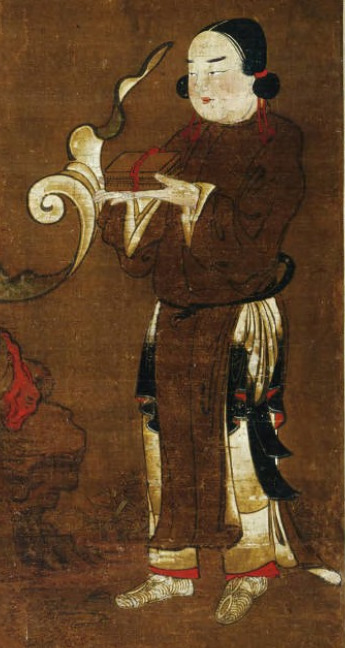
Zennishi Dōji (Princeton University Art Museum; reproduced here for educational purposes only)
Yoshiaki Shimizu has suggested that the connection between Myōren and his Gohō Dōji is meant to mirror that between Bishamonten and his son and primary attendant, Zennishi Dōji (善膩師童子), and highlight that the monk was an incarnation of the deity he worshiped. He also argued that Myōren’s nameless sister (not attested outside Shigisan Engi Emaki) - the character ZUN based Byakuren on - is meant to correspond to Bishamonten’s wife, Kisshōten/Kichijōten (presumably with spousal bond turned into a sibling one). I am not sure if this proposal found broader support, though - I’m personally skeptical.
Kongara Dōji (and Seitaka Dōji): almost Touhou
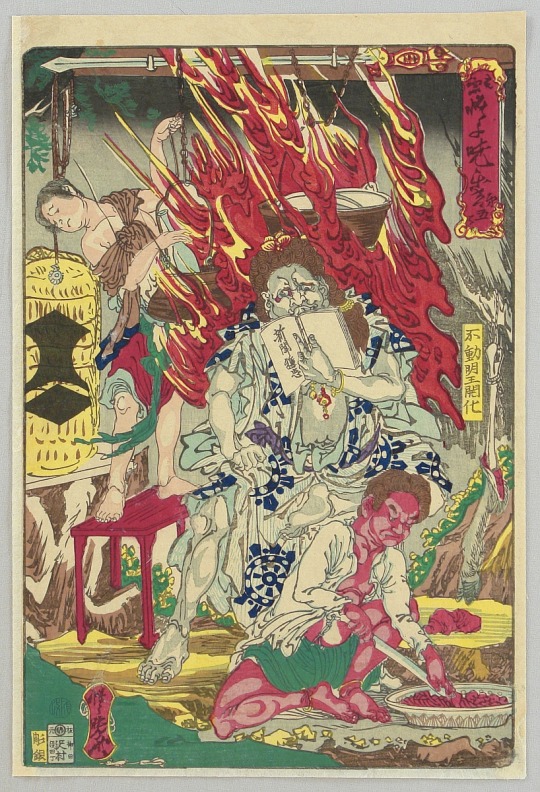
Fudō Myōō, as depicted by Kyōsai (via ukiyo-e.org; reproduced here for educational purposes only)
Kongara Dōji (衿羯羅童子, from Sanskrit Kiṃkara) and Seitaka Dōji (制多迦童子, from Sanskrit Ceṭaka) are arguably uniquely important as far as the divine dōji go - a case can be made that they were the model for the other similar pairs. They are regarded as attendants of Fudō Myōō (Acala), one of the “wisdom kings”, a class of wrathful deities originally regarded as personifications and protectors of a specific mantra or dhāraṇī. In Japanese esoteric Buddhism, they are understood as manifestations of Buddhas responsible for subjugating beings who do not embrace Buddhist teachings.
Acting as Fudō‘s servants is the primary role of Kongara and Seitaka. As a matter of fact, both of their names are derived from Sanskrit terms referring to servitude. This is not reflected in their behavior fully: esoteric Buddhist sources indicate that Kongara is guaranteed to help a devotee who would implore him for help, but Seitaka is likely to disobey such a person. Interestingly, both can be recognized as manifestations of Fudō. This seems to reflect a broader pattern: once a deity ascended to a prominent position in esoteric Buddhism, some of their functions could be reassigned to members of their entourage. ZUN arguably references this in Mai and Satono’s bio, according to which “their abilities (...) are nothing more than an extension of Okina's.”
Despite the aforementioned shared aspect of their nature, Kongara and Seitaka actually have completely different iconographies. Kongara is portrayed with pale skin, wearing a monastic robe (kesa) and with his hands typically joined in a gesture of respect. Seitaka, meanwhile, has red skin, and holds a vajra in his left hand and a staff in the right. His characteristic five tufts of hair are a hairdo historically associated with people who were sentenced to banishment or enslavement. He’s never portrayed wearing a kesa in order to stress that in contrast with his “coworker” he possesses an evil nature. It has been argued the fundamental ambivalence of dōji is behind this difference in temperaments.
While the pair consisting of Kongara and Seitaka represents the most common version of Fudō’s entourage, he could also be portrayed alongside eight (a Chinese tradition) or uncommonly thirty six attendants. The core two are always present no matter how many extra dōji are present, though. Appearing together is essentially their core trait, and probably is part of the reason why they could be identified with other duos of supernatural servants, like En no Gyōja’s attendants Zenki and Gōki (who as you may know are referenced in Touhou in one of Ran’s PCB spell cards, and in a variety of print works).
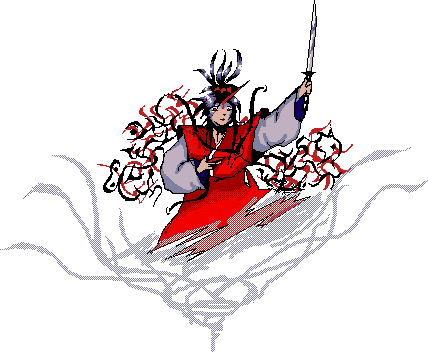
As for the Touhou relevance of Kongara and Seitaka, a character very obviously named after the former appeared all the way back in Highly Responsive to Prayers, but I will admit I am personally skeptical if this can be considered an actual case of adaptation of a religious figure. There are no iconographic similarities between them, and their roles to put it lightly also don't seem particularly similar. Much like the PC-98 use of the term makai (which I will cover next month), it just seems like a random choice.
At least back in the day there was a fanon trend of treating the HRtP Konngara as an oni and a fourth deva of the mountain, but I will admit I never quite got that one. In contrast with Yuugi and Kasen’s counterparts, Kongara's namesake actually doesn’t have anything to do with Shuten Dōji.
The less said about a nonsensical comment on the wiki asserting Kongara’s status as a yaksha (something I have not seen referenced outside of Touhou headcanons, mostly from the reddit/tvtropes side of the fandom) explains why his supposed Touhou counterpart is present in hell, the better.
Uhō Dōji: my life as a teenage Amaterasu protector of gumonji practitioners

Uhō Dōji (Metropolitan Museum of Art)
Uhō Dōji (雨宝童子), “rain treasure child”, will be the last dōji to be discussed here due to being by far the single most unusual member of this category. Following most authors, I described Uhō Dōji as a male figure through the article, but as noted by Anna Andreeva, most depictions are fairly androgynous. Bernard Faure points out sources which seem to refer to Uhō Dōji as female exist too; this is why I went with a gender neutral translation of dōji. In any case, the iconography is fairly consistent, as documented already in the Heian period: youthful face, long hair, wish-fulfilling jewel in one hand, decorated staff in the other, plus somewhat unconventional headwear, namely a five-wheeled stupa (gorintō).
Originally Uhō Dōji was simply a guardian deity of Mount Asama. He is closely associated with Kongōshō-ji, dedicated to the bodhisattva Kokūzō. The latter is locally depicted with Uhō Dōji and Myōjō Tenshi (明星天子), a personification of Venus, as his attendants.Originally the temple was associated with the Shingon school of Buddhism, though today it instead belongs to the Rinzai lineage of Zen.
A legend from the Muromachi period states that Kongōshō-ji was originally established in the sixth century, during the reign of emperor Kinmei by a monk named Kyōtai Shōnin (暁台上人).The latter initially created a place for himself to perform a ritual popularly known as gumonji (properly Gumonji-hō, 求聞持法, “inquiring and retaining [in one’s mind]”).The name Kongōshōji was only given to it later when Kūkai, the founder of the Shingon school of Buddhism (from whose traditions gumonji originates), received two visions - one from a dōji and then another from Amaterasu - that a place suitable to perform gumonji exists on Mount Asama. After arriving there, he stumbled upon the ruins of Kyōtai Shōnin’s temple, so he had it rebuilt and renamed it. Subsequently, Amaterasu appointed Uhō Dōji to the position of the protector of both this location and Buddhist devotees partaking in gumonji in general.
Most of you probably know that gumonji pops up in Touhou as the name of Akyuu’s ability in Perfect Memento in Strict Sense. ZUN describes it simply as perfect memory, but in reality it’s an esoteric religious practice focused on chanting the mantra of Kokūzō 1000000 times over the course of a set period of time (either 100 or 50 days). The goal is to develop perfect memory in order to be able to memorize all Shingon texts, though it is also believed to increase merit and grant prosperity in general. The oldest references to it come from the eighth century, and based on press coverage it is still performed today.
ZUN actually never mentioned gumonji in a context which would stress the term’s Buddhist character. In Forbidden Scrollery Akyuu prays to Iwanagahime rather than to any Buddhist figures. I get the idea behind that, but I will admit I liked the portrayal of her religious activities in Ashiyama’s Gensokyo of Humans much more.

Gumonji aside, the second major point of interest is the connection between Uhō Dōji and Amaterasu. In the legend I’ve summarized above, they are obviously two separate figures, with one taking a subordinate position. This changed later on, though. At some point, most likely between 1419 and 1428, the two deities came to be conflated. As Bernard Faure put it, Uhō Dōji effectively came to be seen as the “Buddhist version of Amaterasu”. To be specific, as Amaterasu at the age of sixteen, presumably to account for the fact that a dōji would by default be a youthful figure.
The treatise Uhō Dōji Keibyaku goes further and asserts that that Uhō Dōji manifests in India as the historical Buddha, Amida and Dainichi; in China as Fuxi, Shennong and Huang Di; and in Japan as Amaterasu, Tsukuyomi and Ninigi. In his astral role, he represents the planet Venus, but he can also manifest as Dakiniten and Benzaiten, in this context understood as respectively lunar and solar. He is also the creator of all of these astral bodies.
The grandiose claims about Uhō Dōji, Amaterasu and other major figures were not exactly uncontroversial. It seems that especially in the eighteenth century the Ise clergy objected to them, presumably because they effectively amounted to their peers at Kongōshō-ji promoting their own deity to make the temple more important as a part of the Ise pilgrimage, which at the time enjoyed considerable popularity.
The association between Amaterasu and Uhō Dōji nonetheless persisted through the Edo period, and despite protests voiced at Ise among laypeople Mount Asama was widely recognized as the third most important destination for participants in the Ise pilgrimage, next to the outer and inner shrines at Ise themselves. It is also quite likely that there was no shortage of people who would imagine Amaterasu looking just like Uhō Dōji.
Ultimately the Uhō Dōji controversy was just one of the many chapters in Amaterasu’s long and complex history, and there was nothing particularly unusual about the claims made. There were quite literally dozens of Buddhist or at least Buddhist-adjacent figures she developed connections to (Bonten, Enma and Mara, to name but a few), and the Ise clergy took active part in this process. Buddhist reinterpretations of Amaterasu flourished especially through the Japanese middle ages.
It was only the era of Meiji reforms that brought the end to this, cementing the Kojiki and Nihon Shoki inspired vision of Amaterasu as the only appropriate one. However, this is beyond the scope of this article. Worry not, though: the very next one I’m working on will cover these matters in detail. Please look forward to it.
Bibliography
Anna Andreeva, “To Overcome the Tyranny of Time”: Stars, Buddhas, and the Arts of Perfect Memory at Mt. Asama
Talia J. Andrei, The Elderly Nun, the Rain-Treasure Child, and the Wish-Fulfilling Jewel: Visualizing Buddhist Networks at the Grand Shrine of Ise
William M. Bodiford, Matara: A Dream King Between Insight and Imagination
Bernard Faure, The Fluid Pantheon (Gods of Medieval Japan vol. 1)
Idem, Protectors and Predators (Gods of Medieval Japan vol. 2)
Idem, Rage and Ravage (Gods of Medieval Japan vol. 3)
Nobumi Iyanaga, Tachikawa-ryū in: Esoteric Buddhism and the Tantras in East Asia
Gaétan Rappo, Heresy and Liminality in Shingon Buddhism: Deciphering a 15th Century Treatise on Right and Wrong
Idem, “Deviant Teachings”. The Tachikawa Lineage as a Moving Concept in Japanese Buddhism
Yoshiaki Shimizu, The "Shigisan-engi" Scrolls, c. 1175
107 notes
·
View notes
Text
One thing I tend to see really disparate takes on is how much of Stede's presentation is masculine or feminine, and I keep thinking about it. The tricky thing is that of course standards of masculinity have changed between the early eighteenth century and now, and at the same time this production is very much not one that's going to be historically accurate in such a way that it confuses the audience!
So, 1717 masculinity first.
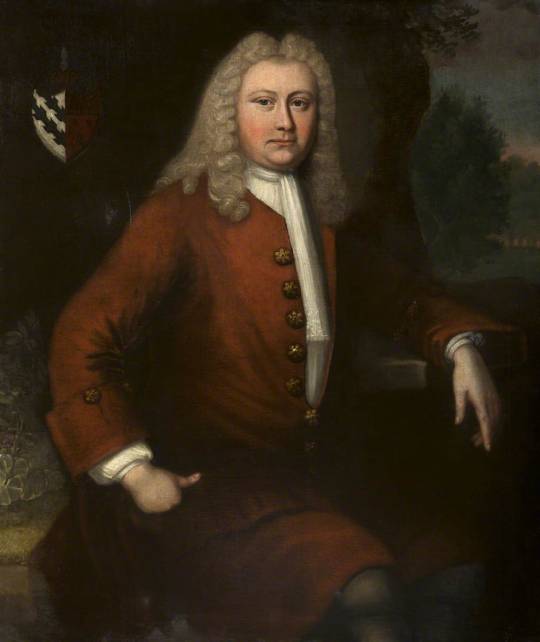

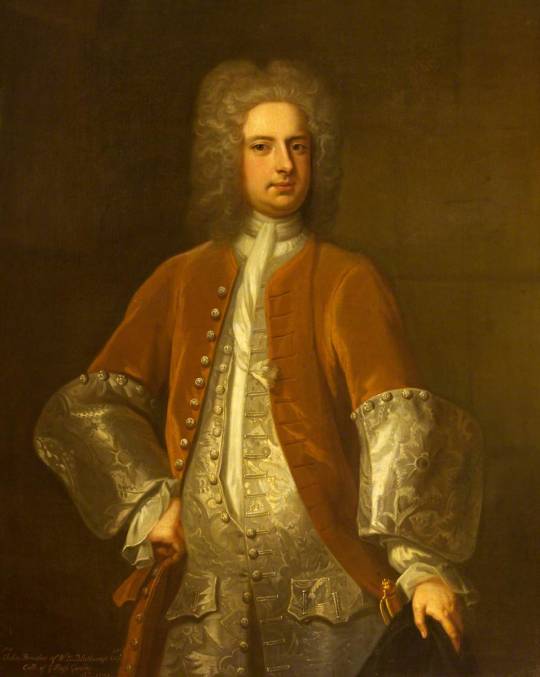

There's a stereotype that prior to Beau Brummell, there was no sense that men should be restrained in dress, but it's not true at all. Even in the 1710s and 1720s, English gentlemen were expected to have a certain soberness in their clothing - portraits show a preponderance of browns, as well as darker blues, greys, and occasionally reds; there's not that much trim, either, beyond buttons and occasionally a line of gold or silver braid. John Blathwayt is among the flashier, with a waistcoat and massive cuffs made out of a silvery damask - but attached to a brown silk (and really, grey-on-grey isn't that flamboyant). To a modern eye, the flowing wigs and stockinged calves relate to women's fashion, but both were symbols of masculinity in the period - women's hairstyles were more contained and natural, and their legs were covered with skirts.




The clothes Stede wears in the scenes set before he goes to sea generally reflect these norms. They're in darker tones, and cut fairly loose and not showing off his body. The orangey-brown anniversary outfit has the lightest colors and the closest fit, and it's still shades of brown and a pretty boxy shape. His cravat is often lacy, which really isn't very masculine for the period, but it's partially covered with a colored tie/secondary cravat - along with his lacy shirt cuffs, that's definitely something that can be read as a small expression of his style/queerness, which he's also half-concealing. In the betrothal scene, his cravat is actually a strangely rough fabric in a light grey, and I think it's tucked into his waistcoat so we can't actually see the ends.

I also want to note that the suit fabric really matches the upholstery in Stede's father's carriage. It's hard for me to not read this outfit as being chosen by Bonnet the elder to repress anything non-masculine about Stede, and also to show him as a possession, just like the carriage. On the other hand, the anniversary suit seems to be the brightest and most fitted, with a contrasting and I think floral-patterned waistcoat, and that was the scene where Stede tries to be more open than he's ever been with Mary about what he likes and wants.
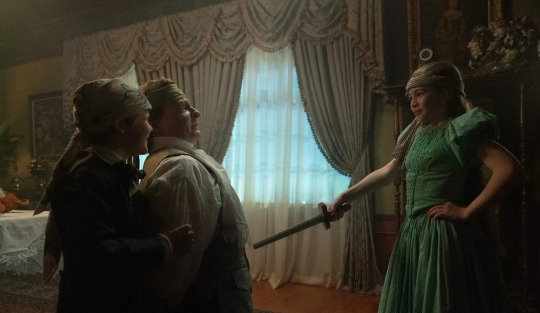
There's a similar thing in the scene where Mary tells Stede to play with Alma and Louis. He starts off reading and ignoring Mary in a plain dark green coat, the ends of his cravat hidden behind his book and the top of it largely covered with a green tie. Then we jump cut to him playing with the kids and he has taken off the plain coat to reveal a patterned, light blue waistcoat (short and fitted), and he's tied the green tie around his head to uncover the white cravat, which is also revealed to have intricate lacy ends. Likewise, when he runs away to sea, he wears a fairly yellow waistcoat, embroidered with flowers - the only embroidery we see on him in the flashbacks apart from a little bit on his nightshirt right before he runs away.
So, how does this compare to what he wears as Captain Bonnet? (Part II)
#ofmd#ofmd costuming#our flag means death#ofmd meta#our flag means death costuming#stede bonnet#18th century english masculinity
1K notes
·
View notes
Note
Hey there! Hope everything's going great
Sooo I had a request:
I had this thought about what if s/o and op men had a little argument on something and they decide to give silent treatment to each other for a while, they still do stuff together like going shopping for stuff with the crew but this little incident happens where a guy flirts with s/o infront of their partner and she (yep female s/o) says she's single XD
Like a headcanon on how they would react to this? It can be a funny one
I'd specifically like sabo, law, zoro and coby for this!
Thank youuuu so muchhhh if you'll do this take care! ^^ ♡
I included Ace in this as well because I love him. Sabo, Law, Zoro, Koby, Ace.
Warnings: arguments, threats, almost violence, heartbreak, hurt/comfort,
Word Count:1720
Your fights never got this bad, never got out of control like this. Normally, you were able to work it out, or at least take some time to cool down first. But you’d both been in a bad mood, both said things you shouldn’t have, both been rather stupid to be honest. It should have been a minor argument, should have been simple grumbling followed by comforting hugs and cuddles, maybe a nap. Instead, it had ended up with you both storming off in an even worse mood than you’d already been in, it had ended with you both giving each other the silent treatment, and with extremely high tensions whenever you were together. Few, if any, of your friends said anything, not wanting to get caught up in your fight or be on the receiving end of your wrath, but the tension was getting uncomfortable… well, more uncomfortable. A simple shopping trip with the others, that’s all it was. Get some supplies, look around, it wouldn’t be the two of you alone, so it’s not like it would be uncomfortable silence the entire way, you could both talk to someone who wasn’t each other. It had been while you’d been in a clothing shop, looking at various clothes that he approached you. Tall, handsome, with a gorgeous smile.
“Hey there, beautiful. Noticed you looking at these. If I may be so bold, I think this would look much better on you.” he said, holding out a beautiful dress. Running your fingers over the fabric, you smiled, you did look good in this color, maybe it was worth at least trying on.
“Tell me how I look?” you asked, taking the dress, the man following you towards the dressing rooms. As soon as you stepped out, the man was taking your hand, kissing the back before helping give you a little spin.
“You look dazzling. I was wondering, if a beautiful woman like you would perhaps join me for dinner? That is, unless you’re already taken.” he said, giving you another thousand watt smile. You hesitated for a moment. The two of you hadn’t talked in well over a week, or had it been longer? You were both too busy fuming to keep track, still stubbornly refusing to talk to each other.
“No, I’m single and I’d love to accompany you.” you said with a soft smile.
Sabo
Head immediately whips around to look at you.
Heartbroken and angry.
Single? Was this your way of breaking up with him?
Immediately marches over, tells the guy you’re actually taken and then drags you away.
Pulls you somewhere secluded so you can talk.
Totally pins you to the wall.
Calls you both stubborn and says that the fight was stupid.
He’s angry because of the guy but he’s also super scared of losing you.
Pulls you close and holds you, telling you you’re his and that he won’t let some stupid fight change that.
If you don’t apologize for the fight or want to break up, his heart will 100% shatter.
He’s lost enough, you were the ray of sunshine in his life, he can’t lose you too.
Doesn’t actually say anything though, just walks away.
You can’t tell if he’s angry or sad from the way he leaves.
Won’t talk to anyone unless necessary for days and completely avoids you.
So, so heartbroken, absolutely cries when he’s alone.
Thinks he has to be strong for the Revolutionary Army though, so will put on a smile around others.
If you both apologize.
Refuses to let you go after that, if you let him, he’ll absolutely carry you everywhere, but if you don’t, he won’t let go of your hand. At. All.
Super possessive all day.
Pulls you into his room to sleep with you.
I hope you don’t have to get up in the middle of the night, because he won’t let you go.
Seriously, wrapped completely around you, holding you tight, you just are not going anywhere.
Steals or buys all sorts of gifts for you. Anything he thinks you might like.
Even if you’re both at fault, he’s trying so hard to make up for the fight.
Law
Excuse me, what?
Straight up shambles the guy away, like as far as his room will allow.
Super duper pissed.
Demands to know why you said you were single.
If you say that you’re breaking up with him, his heart will break.
Not even kidding, will storm off to the Polar Tang, lock himself in his room and cry.
If you say someting like ‘he was acting like you weren’t together anymore’, he’ll freeze up
Had he really been that stubborn and stupid?
Shambles you both back to the ship and holds you close.
Tells you that he can’t lose you.
Surprisingly sweet. Is this really your Law? Because he’s being way too affectionate.
Absolutely makes it up to you. Takes you back out shopping, if you so much as look at something with vague interest, he’ll either buy it or steal it for you.
Takes you out to a very nice (secluded) dinner that night. Holds you close all night, like, I hope you don’t mind sleeping in his bed with his arms wrapped around you, because it will happen.
Doesn’t let you out of his sight the entire time you’re docked.
Zoro
Almost slices the entire store (and the guy) into pieces.
You’re WHAT?
So, so, so angry.
Also scared, though he won’t admit it.
Scares the guy away.
Picks you up, throws you over his shoulder, and takes you back to the Sunny.
You can’t tell if he’s more angry or hurt as he looks at you.
Simply states that you’re his.
If you tell him you aren’t and that you’re breaking up with him.
Just storms off.
Goes to his gym and starts working out to try and blow off some steam.
Spends an unusual amount of time in the gym from now on.
Can’t look at you because it hurts too much.
Still totally loves you.
He doesn’t even insult Sanji for days.
If you forgive him.
Wraps his arms around you and holds you close.
Just stays like that for a while.
Keeps an arm wrapped around you all day as you go shopping.
In so much debt to Nami now because he borrowed so much money.
Isn’t able to buy you everything you look at, but if you express any sort of desire over it, he’ll buy it.
Keeps you close for weeks. He’s training? Well, I hope you wanted to watch him work out. He’s taking a nap? You’re taking a nap too.
I hope you don’t mind sleeping in the boy’s dorm because Nami absolutely will not let him sleep in the girl’s dorm.
Koby
Immediately rushes over to you.
Are you serious? Does this mean you’re breaking up with him? He’s so, so, so, so sorry.
Completely ignoring the guy as he takes your hands in his.
Eyes are so hurt and scared and a little desperate.
Begs you to forgive him.
If you break up with him.
Absolutely starts tearing up then and there.
Quietly walks away as he starts crying. Returns to his room and starts sobbing.
Beats himself up for getting into the fight in the first place.
SO different from his usual self!
Just super quiet and downcast.
It’s like he reverted back to when he was working for Alvida but without the hope for something better.
His rank and abilities totally suffer because of how heartbroken he is.
Like, everyone is wondering, is this really the same Captain Koby?
Does eventually, sort of bounce back, but is super focused on only work.
If you forgive him.
Clings to you, just wrapps you in a huge hug, apologizing over and over.
Still crying a little but so, so relieved.
Buys. You. Everything!
Seriously, I hope you plan to look at the ground the entire time, because if you even glance at it, he’s buying it, trying to make things up to you.
Even if he knows it’s both of your faults, he doesn’t care, he feels like he needs to apologize and make it up to you.
Spoils you rotten for weeks.
A little meek around you for a bit, but does perk up and return to normal after a bit.
Cuddles with you whenever possible. Like, if he has even a minute to spare, he’s got his arms wrapped around you.
Ace
Literally lights on fire as he stalks over to the man.
Almost lights the guy on fire.
Not sure who to feel more sorry for. Ace for feeling so scared and heartbroken or the man for being so terrified.
Pulls you away immediately.
As soon as your somewhere secluded, he wraps his arms around you and doesn’t let go.
Apologizing over and over.
Please don’t leave him, he’ll do anything, whatever you ask.
If you don’t forgive him. Stands there in stunned silence while you walk away.
100% crying.
So, so despondent as he walks back to the Moby Dick.
Locks himself in his cabin, refuses to come out.
Barely eats and Thatch has to deliver it to Ace because Ace won’t come out.
Nobody hears his sobbing, but it’s a miracle he doesn’t die of dehydration.
You were the best thing to happen to him.
You think he was depressed over his past before?
1000x worse now.
Absolutely thinks he’s trash for losing you.
Doesn’t necessarily bounce back, but returns to his commander duties again.
If you forgive him.
Holding you even tighter.
Can’t stop himself from crying into your shoulder.
So, so scared he was going to lose you.
Once he manages to gather himself together again, he takes you back to the ship.
He doesn’t buy you everything but that’s because he just wants to hold you.
You spend the entire week simply cuddling with him.
Will not let you go. Eating dinner? You’re in his lap. Sleeping? He’s holding you tightly like a teddy bear. Just relaxing? He’s cuddled up with you.
I hope you don’t need to train, because he won’t let you go long enough to do so.
Whitebeard eventually has to order him to return to him commander duties because he’s so busy clinging to you.
#one piece#one piece ace#portgas d. ace#fire fist ace#portgas d ace#one piece sabo#ace x reader#fire fist ace x reader#portgas d ace x reader#sabo the revolutionary#hiken no ace#hiken no ace x reader#portgas d. ace x reader#chief of staff sabo#second division commander ace#flame emperor sabo#flame emperor sabo x reader#chief of staff sabo x reader#sabo x reader#op Sabo#op Ace#sabo the revolutionary x reader#one piece zoro#op zoro#zoro roronoa#zoro roronoa x reader#roronoa zoro#roronoa zoro x reader#Zoro x reader#king of hell zoro x reader
359 notes
·
View notes